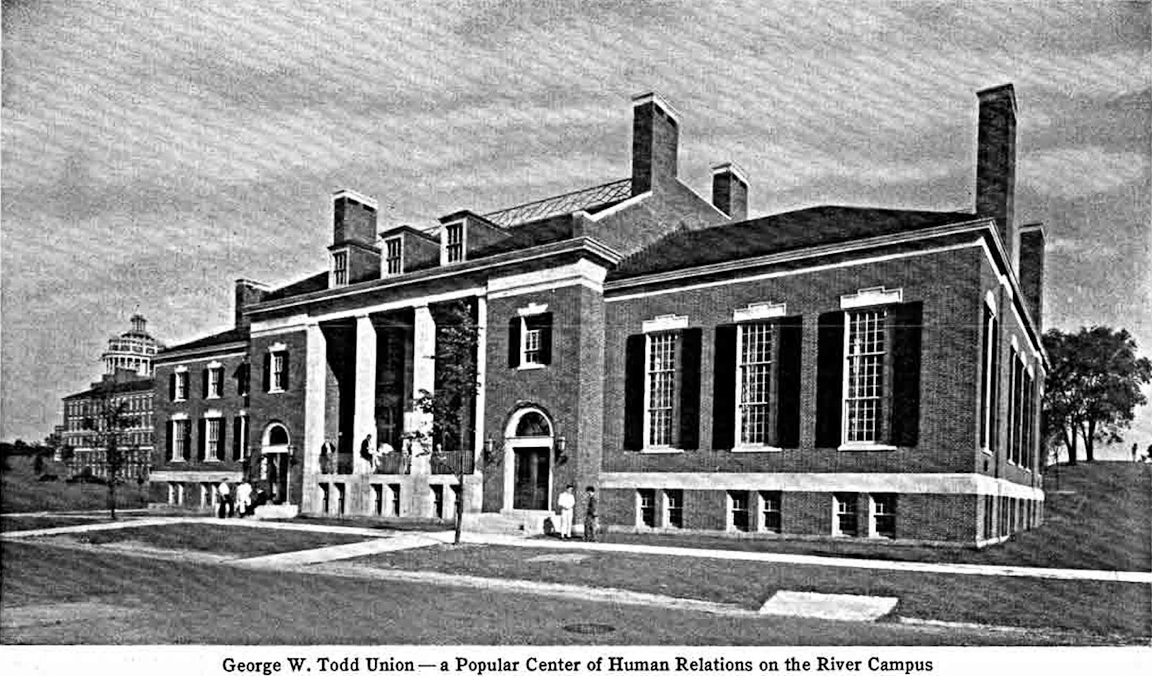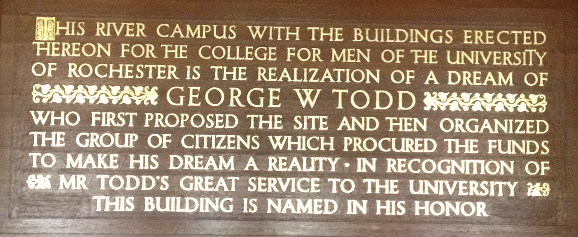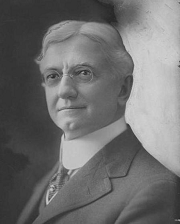
| River Campus | Todd Union |
 |
 |
 |
Todd Union was opened in October, 1930 behind Strong Auditorium. It was named for George W. Todd, who originated the idea of purchasing Oak Hill golf course for use as the UR campus. Deeply interested in a place for students, Todd organized a group of citizens who procured funds to create a student union.
References
1924 "A
Sleepless Night and a Great Vision," Rochester Review
3(2):38-39 (December-January 1924-25)
1930 "Name
of Rush Rhees Given to New Library," Rochester Review
8(5):131-132 (June-July 1930)
George W. Todd Union
Nor would it be in the least fitting if the name of George W. Todd were
omitted from permanent association with the new campus. For he it was who
first envisioned the possibilities of the river site and the Greater
University movement, when the need of expanding the college became
apparent with the establishment of the School of Medicine and Dentistry.
In originally reporting the campaign in this magazine we stated that Mr.
Todd had made two contributions to it – one sleepless night and $100,000.
As noteworthy as was the latter, the former was probably more significant,
for it was during that sleepless night that he first dreamed the dream of
a new college on the rolling acres of what was then the Oak Hill site.
With the aid of the late James S. Havens, who became similarly inspired at
about the same time, Mr. Todd gradually sold the idea to other civic
leaders, including Mr. Eastman, until the Greater University Campaign
materialized. And in that great undertaking he served effectively as
general chairman of the campaign organization. Because of this
background of associations it has been decreed that the Student Union
shall be known as the George W. Todd Union. It is well that his name
is to be perpetuated by that beautiful and uniquely useful building.
1930 The Schiff Photographs of the River Campus | Todd Union | Interior Images |
1931 "The
Story Back of Todd Union," Rochester Review 10(2):3-6
(October-November 1931)
A Comfortable Campus Club for Students and Alumni.
1938 "A
Small College Union," by Carl Lauterbach, American School and
University 10:482-483 (1938)
Includes building floor plans.
1938 "George
Todd Dies; Rochester Leader; Industrialist and Business Man Was Founder
of the Todd Protectograph Company," The New York Times,
March 20, 1938, Page 8.
George W. Todd, founder with his brother Libanus of the Todd Protectograph
Company, died tonight at his home here at the age of 78. He had been ill
for four years.
The founding of a firm for marketing a protector of bank checks was only
one of the many accomplishments of Mr. Todd, industrialist, business man
and philanthropist.
Few community enterprises in Rochester lacked the helping hand of Mr.
Todd, for his benefactions, both publin and private, were many The
University of Rochester long knew him as a patron, and to his vision was
credited the movement in 1925 for a greater institution.
Mr. Todd had many years but few birthdays in his life, for he was born on
Feb. 29. His parents, Asahel and Sarach McLouth Todd, educated him in the
village school at Pultneyville, where he was born in 1860, and in the high
school at Williamstown and the Academy at Walworth .
The year 1890 found him at Lansing, Mich., where he entered the
manufacturing business. In 1892 he moved to Chicago and four years later
came to Rochester, where he associated himself with the Lower Sole Rounder
Company and later with the Reed Chemical Company.
In 1899 the Todd Protectograph Company was founded. He was also president
of the Stromberg-Carlson Telephone Manufacturing Company and a director of
the Eastman Kodak Company, the Lincoln-Alliance Bank and the Rochester
Printing Company. He was treasurer and a director of the General Indemnity
Company of America.
Mr. Todd's interest in municipal affairs led him to accept a trusteeship
in the _Rochester Bureau of Municipal Research and directorships in the
Eastman School of Music, the Rochester Community Chest, the Rochester
Dental Dispensary and the Highland Hospital.
He was a Republican in politics, and one of his more spectacular
accomplishments had a political background. While living in the West in
1884 he had a part in the controversy that attended the founding of the
town of Gettysburg, S. D. The result of the dispute was that Mr. Todd and
a group of youthful associates transported the Potter County Court House
from Forest City to Gettysburg, which since has been the county seat.
He also made large gifts to Cornell University, which his sons attended.
His widow, a sister and three sons, Walter. George and Donald survive.
1938 George Walter Todd (1860-1938) Grave in Riverside Cemetery, Rochester, New York
1973 "Pearson Examines Future of Todd Union," Campus Times, March 1, 1973, Page 1.
1977 History
of the University of Rochester, 1850-1962, by Arthur J.
May. Expanded edition with notes
Chapter 22, Oak Hill Becomes River Campus
At about the same time, Rhees confidentially disclosed to George W. Todd
the program for a medical center which George Eastman had promised to
finance in part. Todd knew Eastman well and indeed had represented him in
several important transactions connected with the construction and
staffing of the music center. Along with a directorship in the Kodak
Company, Todd collaborated with Eastman as a trustee of the Dental
Dispensary, on the Bureau of Municipal Research, and at the Chamber of
Commerce; during Todd's term as president of the Chamber Eastman agreed to
pay for the construction of its present (1968) home. Neither man was
college trained; both were self-made individuals, as the saying goes, and
cherished much the same basic outlook on life.
Although born near Rochester, Todd spent his youth and early manhood in
the Middle West, engaging in a variety of real estate and manufacturing
operations. Not long after returning to Rochester, he teamed up with his
brother, Libanus, in establishing in 1899 a small shop which turned out
reliable protective devices for bank cheques, invented by Libanus. The
firm prospered, rapidly acquired an international reputation, and absorbed
smaller companies producing office supplies.
A major architect of twentieth century Rochester, Todd was a man to whom
the city owed a great deal. It was said correctly that few community
undertakings lacked his helping hand and that "once he was interested in
an institution his interest in it never flagged." Top place among those
institutions in the 1920's was the University of which he became and
remained a leading patron.
Todd and Rhees lived on terms of friendly intimacy, and his family
occupied the presidential residence when the Rhees' were abroad while a
new Todd home was being finished. "I want to tell you about a brainstorm
I've got," he is quoted as having said to friends, and proceeded to
outline a plan for a splendid collegiate institution on the grounds of the
Oak Hill Country Club, overlooking the Genesee. Aided and abetted by an
influential Rochester attorney and ex-Congressman, James S. Havens, Todd
converted Eastman, who had strongly favored expansion in the Prince Street
area, to the Oak Hill idea.
Paying tribute to Todd as a man whom the University "has abiding cause to
remember with grateful appreciation," Rhees declared, "It was he who had
the vision, at first regarded as chimerical, which was realized for us and
for Rochester in the development of our River Campus 'beside the Genesee.'
It was he, also, who challenged the imagination of our citizens to embark
on the enterprise of raising ten million dollars to make his vision a
reality, and who led in that undertaking, giving himself one hundred
thousand dollars to realize his dream. It was he who changed Mr. Eastman's
frank hostility to enthusiasm for the project and its realization...."
Elated by the trustee verdict, Todd offered to organize a special
committee of public-spirited Rochesterians to direct a campaign for funds,
which, he recommended, might appropriately be conducted in the autumn of
1922. A committee was in fact created, though the appeal for money was
postponed. Todd had a realistic, business-like attitude with regard to
raising the money required; it would be a formidable task, he appreciated,
to convince Rochesterians that existing facilities for collegiate
education were insufficient before the music and medical centers had been
firmly established; and it would take some doing to persuade prospective
donors that residence halls were indispensable for nourishing college
spirit, without which "no institution can become great."
Chapter 27, Undergraduates and Graduates in the Thirties
For the general life of the students, Todd Union quickly proved its worth
and invited imitation by similar institutions at colleges across the
Republic. Any student might become a member for a fee of ten dollars, and
the Union was first managed by a twelve-man board, which in 1936
relinquished its responsibilities to the Board of Control. This body,
composed of two alumni, three faculty, the University treasurer, and four
(later six) elected undergraduates, largely conducted its affairs through
committees: executive or budget, athletic, non-athletic, team and club
managers.
Todd Union amenities for lounging, carefree reading, and games became so
frequented that as early as 1935 calls went up for expansion of the
building. It was the scene of dances and more dances, coffee hours,
college (and alumni) dinners, and "fireside chats" with interesting
Rochesterians as guests. The bookstore and shops rendered good service and
were careful not to compete on price with city firms.
Todd Director Carl W. Lauterbach, 1925, arranged a Boar's Head Procession
and Dinner in 1934, which grew into one of the best-loved River Campus
traditions. This pre-Christmas party was modeled on an affair at Queens'
College, Oxford, where a medieval undergraduate is said to have escaped
mutilation by a boar by choking the angry creature with a volume of
Aristotle's philosophy; friends of the hero cooked and devoured the
animal. At Rochester trumpeters heralded the start of the festival, the
Baron of Rochester and his guests took seats at the head table, and
professors assumed the boring task of carvers.
2023 Todd
Union earns historic designation, March 20, 2023
Recognized as a “key site associated with Rochester’s LGBTQ+ history,” the
University of Rochester’s Todd Union has been recommended by New York
State’s Board for Historic Preservation to be added to the State and
National Registers of Historic Places. Gov. Kathy Hochul recently
announced the board’s approval of Todd Union and 12 other sites to be
included on the registries. Significantly, inclusion on the State and
National Registers of Historic Places makes these properties eligible for
various public preservation programs, grants, and services.
Constructed in 1930 on the University’s River Campus, Todd Union is a
Georgian Revival style building designed by Rochester architectural firm
Gordon & Kaelber. It was originally built to be a campus activity hub
and included dining, social, shopping, barber, game, and club facilities
for students, which were only men at the time of construction. Todd Union
has an early and significant association with the University of
Rochester’s Gay Liberation Front (UR GLF), an organization that worked to
advance the gay liberation movement on campus and in the city of Rochester
in the 1970s. Based out of an office in Todd Union, the UR GLF directly
paved the way for numerous Rochester-based LGBTQ+ organizations that
continue their work and advocacy more than 50 years later.
Today, the two-and-one-half-story Todd Union retains many of its original
features, such as historic staircases, doors, fireplaces, wainscoting,
window and door trim, and the post office boxes in the basement.
Inclusion on the State and National Registers of Historic Places involves
a lengthy process. Todd Union was nominated by a team of Rochester
faculty, staff, and an alumnus and student. Planning and Project
Management (PPM) in University Facilities & Services led the effort in
partnership with the Landmark Society of Western New York. Contributions
to the application came from Col E. Raimond, the director of LGBTQ Life;
Gerald Gamm, a professor of political science and of history; and Melissa
Mead, the John M. and Barbara Keil University Archivist and Rochester
Collections Librarian.
Having been approved by the New York State Historic Preservation Officer,
Todd Union will be listed on the New York State Register of Historic
Places and reviewed by the National Park Service for inclusion in the
National Register. The Park Service makes its decision within 45 days.
© 2021 Morris A. Pierce